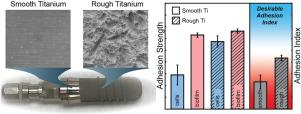Dental Materials ( IF 5 ) Pub Date : 2020-11-15 , DOI: 10.1016/j.dental.2020.10.013 J.D. Boyd , A.J. Stromberg , C.S. Miller , M.E. Grady

|
Objective
The aims of this study are to quantify the adhesion strength differential between an oral bacterial biofilm and an osteoblast-like cell monolayer to a dental implant-simulant surface and develop a metric that quantifies the biocompatible effect of implant surfaces on bacterial and cell adhesion.
Methods
High-amplitude short-duration stress waves generated by laser pulse absorption are used to spall bacteria and cells from titanium substrates. By carefully controlling laser fluence and calibration of laser fluence with applied stress, the adhesion difference between Streptococcus mutans biofilms and MG 63 osteoblast-like cell monolayers on smooth and rough titanium substrates is obtained. The ratio of cell adhesion strength to biofilm adhesion strength (i.e., Adhesion Index) is determined as a nondimensionalized parameter for biocompatibility assessment.
Results
Adhesion strength of 143 MPa, with a 95% C.I. (114, 176), is measured for MG 63 cells on smooth titanium and 292 MPa, with a 95% C.I. (267, 306), on roughened titanium. Adhesion strength for S. mutans on smooth titanium is 320 MPa, with a 95% C.I. (304, 333), and remained relatively constant at 332 MPa, with a 95% C.I. (324, 343), on roughened titanium. The calculated Adhesion Index for smooth titanium is 0.451, with a 95% C.I. (0.267, 0.622), which increased to 0.876, with a 95% C.I. (0.780, 0.932), on roughened titanium.
Significance
The laser spallation technique provides a platform to examine the tradeoffs of adhesion modulators on both biofilm and cell adhesion. This tradeoff is characterized by the Adhesion Index, which is proposed to aid biocompatibility screening and could help improve implantation outcomes. The Adhesion Index is implemented to determine surface factors that promote favorable adhesion of cells greater than biofilms. Here, an Adhesion Index ≫ 1 suggests favorable biocompatibility.
中文翻译:

通过激光剥落技术在牙种植体表面上的生物膜和细胞粘附强度
目的
这项研究的目的是量化口腔细菌生物膜和成骨细胞样细胞单层与牙科植入物模拟表面之间的粘附强度差异,并开发一种度量标准,以量化植入物表面对细菌和细胞粘附的生物相容性作用。
方法
由激光脉冲吸收产生的高幅值短时应力波被用来剥落钛基底上的细菌和细胞。通过仔细控制激光能量密度并通过施加应力对激光能量密度进行校准,可以获得变形链球菌生物膜与光滑且粗糙的钛基底上的MG 63成骨细胞样细胞单层之间的粘附力差。细胞粘附强度与生物膜粘附强度之比(即粘附指数)被确定为用于生物相容性评估的无量纲参数。
结果
在光滑的钛上测得的MG 63电池的粘合强度为143 MPa,CI为95%(114,176),在粗糙的钛上测得的292 MPa为95%CI(267,306)。变形链球菌在光滑的钛上的粘附强度为320 MPa,CI为95%(304,333),在粗糙的钛上的粘附强度为332 MPa,CI为95%(324,343)。计算得出的光滑钛的附着指数为0.451,在粗糙的钛上具有95%的CI(0.267,0.622),增加到0.876,具有95%的CI(0.780,0.932)。
意义
激光剥落技术提供了一个平台,可以检查生物膜和细胞粘附上粘附调节剂的权衡。这种折衷的特征在于粘附指数,该指数被提议用于辅助生物相容性筛选并可以帮助改善植入结果。实施粘附指数是为了确定促进细胞比生物膜更好的粘附的表面因素。此处,粘附指数≫ 1表示良好的生物相容性。



























 京公网安备 11010802027423号
京公网安备 11010802027423号